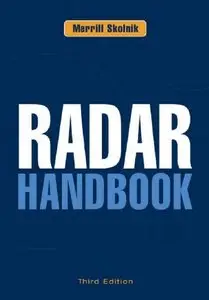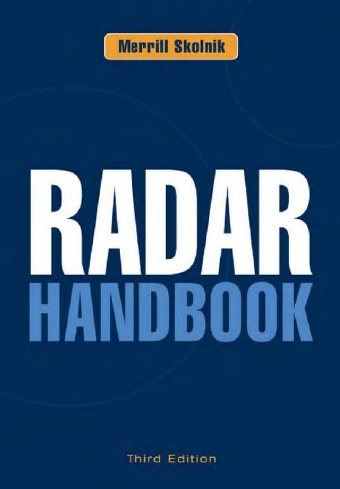"Radar Handbook" ed. by Merrill Skolnik
Third Edition
McGraw-Hill Professional | 2008 | ISBN: 0071485473 9780071485470 | 1352 pages | PDF | 16 MB
Third Edition
McGraw-Hill Professional | 2008 | ISBN: 0071485473 9780071485470 | 1352 pages | PDF | 16 MB
The Industry Standard in Radar Technology Now Updated with All the Advances and Trends of the Past Years. With contributions by 30 world experts, this resource examines methods for predicting radar range and explores radar subsystems such as receivers, transmitters, antennas, data processing, ECCM, and pulse compression. This radar handbook also explains the target cross section…radar echoes from ground and sea… and all radar systems, including MTI, AMTI, pulse doppler, and others.
New to this edition: new chapters on radar digital signal processing, radar in air traffic control, ground penetrating radar, fighter aircraft radar, and civil marine radar; 22 thoroughly revised chapters; 17 new contributors
Inside This Cutting-Edge Radar Guide
• MTI Radar • Pulse Doppler Radar • Multifunctional Radar Systems for Fighter Aircraft
• Radar Receivers • Automatic Detection, Tracking, and Sensor Integration
• Pulse Compression Radar • Radar Transmitters • Reflector Antennas
• Phased Array Radar Antennas • Radar Cross Section • Sea Clutter • Ground Echo
• Space-Based Radar • Meteorological Radar • HF Over-the-Horizon Radar
• Ground Penetrating Radar • Civil Marine Radar • Bistatic Radar • Radar Digital Signal Processing • And More!
CONTENTS
Contributors
Preface
Chapter 1 An Introduction and Overview of Radar - Merrill Skolnik
1.1 Radar in Brief
1.2 Types of Radars
1.3 Information Available from a Radar
1.4 The Radar Equation
1.5 Radar Frequency Letter-band Nomenclature
1.6 Effect of Operating Frequency on Radar
1.7 Radar Nomenclature
1.8 Some Past Advances in Radar
1.9 Applications of Radar
1.10 Conceptual Radar System Design
Chapter 2 MTI Radar - William W. Shrader and Vilhelm Gregers-Hansen
2.1 Preface
2.2 Introduction to MTI Radar
2.3 Clutter Filter Response to Moving Targets
2.4 Clutter Characteristics
2.5 Definitions
2.6 Improvement Factor Calculations
2.7 Optimum Design of Clutter Filters
2.8 MTI Clutter Filter Design
2.9 MTI Filter Design for Weather Radars
2.10 Clutter Filter Bank Design
2.11 Performance Degradation Caused by Receiver Limiting
2.12 Radar System Stability Requirements
2.13 Dynamic Range and A/D Conversion Considerations
2.14 Adaptive MTI
2.15 Radar Clutter Maps
2.16 Sensitivity-velocity Control (SVC)
2.17 Considerations Applicable to MTI Radar Systems
Chapter 3 Airborne MTI - James K. Day and Fred M. Staudaher
3.1 Systems Using Airborne MTI Techniques
3.2 Coverage Considerations
3.3 Airborne MTI Performance Drivers
3.4 Platform Motion and Altitude Effects on MTI Performance
3.5 Platform-motion Compensation Abeam
3.6 Scanning-motion Compensation
3.7 Simultaneous Platform Motion and Scan Compensation
3.8 Platform-motion Compensation, Forward Direction
3.9 Space-time Adaptive Motion Compensation
3.10 Effect of Multiple Spectra
3.11 Example AMTI Radar System
Chapter 4 Pulse Doppler Radar - John P. Stralka and William G. Fedarko
4.1 Characteristics and Applications
4.2 Pulse Doppler Clutter
4.3 Dynamic-range and Stability Requirements
4.4 Range and Doppler Ambiguity Resoluton
4.5 Mode and Waveform Design
4.6 Range Performance
List of Abbreviations
Chapter 5 Multifunctional Radar Systems for Fighter Aircraft - David Lynch, Jr. and Carlo Kopp
5.1 Introduction
5.2 Typical Missions and Modes
5.3 A-A Mode Descriptions & Waveforms
5.4 A-S Mode Descriptions & Waveforms
Chapter 6 Radar Receivers - Michael E. Yeomans
6.1 The Configuration of a Radar Receiver
6.2 Noise and Dynamic-range Considerations
6.3 Bandwidth Considerations
6.4 Receiver Front End
6.5 Local Oscillators
6.6 Gain Control
6.7 Filtering
6.8 Limiters
6.9 I/Q Demodulators
6.10 Analog-to-Digital Converters
6.11 Digital Receivers
6.12 Diplex Operation
6.13 Waveform Generation and Upconversion
Chapter 7 Automatic Detection, Tracking, and Sensor Integration - W. G. Bath and G. V.Trunk
7.1 Introduction
7.2 Automatic Detection
7.3 Automatic Tracking
7.4 Networked Radars
7.5 Unlike-sensor Integration
Chapter 8 Pulse Compression Radar - Michael R. Ducoff and Byron W. Tietjen
8.1 Introduction
8.2 Pulse Compression Waveform Types
8.3 Factors Affecting Choice of Pulse Compression Systems
8.4 Pulse Compression Implementation and Radar System Examples
Appendix
Chapter 9 Tracking Radar - Dean D. Howard
9.1 Introduction
9.2 Monopulse (Simultaneous Lobing)
9.3 Scanning and Lobing
9.4 Servosystems for Tracking Radar
9.5 Target Acquisition and Range Tracking
9.6 Special Monopulse Techniques
9.7 Sources of Error
9.8 Target-caused Errors (Target Noise)
9.9 Other External Causes of Error
9.10 Internal Sources of Error
9.11 Summary of Sources of Error
9.12 Error Reduction Techniques
Chapter 10 The Radar Transmitter - Thomas A. Weil and Merrill Skolnik
10.1 Introduction
10.2 Linear-beam Amplifiers
10.3 Magnetron
10.4 Crossed-field Amplifiers
10.5 Gyrotrons
10.6 Transmitter Spectrum Control
10.7 Grid-controlled Tubes
10.8 Modulators
10.9 Which RF Power Source to Use?
Chapter 11 Solid id-State Transmitters - Michael T. Borkowski
11.1 Introduction
11.2 Advantages of Solid State
11.3 Solid-state Devices
11.4 Designing for the Solid-state Bottle Transmitter
11.5 Designing for the Solid-state Phased Array Transmitter
11.6 Solid-state System Examples
Chapter 12 Reflector Antennas - Michael E. Cooley and Daniel Davis
12.1 Introduction
12.2 Basic Principles and Parameters
12.3 Reflector Antenna Architectures
12.4 Reflector Feeds
12.5 Reflector Antenna Analysis
12.6 Mechanical Design Considerations
Acknowledgments
Chapter 13 Phased Array Radar Antennas - Joe Frank and John D. Richards
13.1 Introduction
13.2 Array Theory
13.3 Planar Arrays and Beam Steering
13.4 Aperture Matching and Mutual Coupling
13.5 Low-sidelobe Phased Arrays
13.6 Quantization Effects
13.7 Bandwidth of Phased Arrays
13.8 Feed Networks (Beamformers)
13.9 Phase Shifters
13.10 Solid-state Modules
13.11 Multiple Simultaneous Receive Beams
13.12 Digital Beamforming
13.13 Radiation Pattern Nulling
13.14 Calibration of Active Phased Array Antennas
13.15 Phased Array Systems
Chapter 14 Radar Cross Section - Eugene F. Knott
14.1 Introduction
14.2 The Concept of Echo Power
14.3 RCS Prediction Techniques
14.4 RCS Measurement Techniques
14.5 Radar Echo Suppression
Chapter 15 Sea Clutter - Lewis B. Wetzel
15.1 Introduction
15.2 The Sea Surface
15.3 Empirical Behavior of Sea Clutter
15.4 Theories and Models of Sea Clutter
15.5 Summary and Conclusions
Chapter 16 Ground Echo - Richard K. Moore
16.1 Introduction
16.2 Parameters Affecting Ground Return
16.3 Theoretical Models and Their Limitations
16.4 Fading of Ground Echoes
16.5 Measurement Techniques for Ground Return
16.6 General Models for Scattering Coefficient (Clutter Models)
16.7 Scattering Coefficient Data
16.8 Polarimetry
16.9 Scattering Coefficient Data Near Grazing
16.10 Imaging Radar Interpretation
Chapter 17 Synthetic Aperture Radar - Roger Sullivan
17.1 Basic Principle of SAR
17.2 Early History of SAR
17.3 Types of SAR
17.4 SAR Resolution
17.5 Key Aspects of SAR
17.6 SAR Image Quality
17.7 Summary of Key SAR Equations
17.8 Special SAR Applications
Chapter 18 Space-Based Remote Sensing Radars - R. Keith Raney
18.1 Perspective
18.2 Synthetic Aperture Radar (SAR)
18.3 Altimeters
18.4 Planetary Radars
18.5 Scatterometers
18.6 Radar Sounders
Chapter 19 Meteorological Radar - R. Jeffrey Keeler and Robert J. Serafin
19.1 Introduction
19.2 The Radar Equation for Meteorological Targets
19.3 Design Considerations
19.4 Signal Processing
19.5 Operational Applications
19.6 Research Applications
Chapter 20 HF Over-the-Horizon Radar - James M. Headrick and Stuart J. Anderson
20.1 Introduction
20.2 The Radar Equation
20.3 Factors Influencing Skywave Radar Design
20.4 The Ionosphere and Radiowave Propagation
20.5 Waveforms for HF Radar
20.6 The Transmitting System
20.7 Radar Cross Section
20.8 Clutter: Echoes from the Environment
20.9 Noise, Interference, and Spectrum Occupancy
20.10 The Receiving System
20.11 Signal Processing and Tracking
20.12 Radar Resource Management
20.13 Radar Performance Modeling
Appendix: HF Surface Wave Radar
Chapter 21 Ground Penetrating Radar - David Daniels
21.1 Introduction
21.2 Physics of Propagation in Materials
21.3 Modeling
21.4 Properties of Materials
21.5 GPR Systems
21.6 Modulation Techniques
21.7 Antennas
21.8 Signal and Image Processing
21.9 Applications
21.10 Licensing
Chapter 22 Civil Marine Radar - Andy Norris
22.1 Introduction
22.2 The Challenges
22.3 International Standards
22.4 Technology
22.5 Target Tracking
22.6 User Interface
22.7 Integration with AIS
22.8 Radar Beacons
22.9 Validation Testing
22.10 Vessel Tracking Services
Appendix The Early Days of CMR
List of Maritime Radar-related Abbreviations
Acknowledgments
Chapter 23 Bistatic Radar - Nicholas J. Willis
23.1 Concept and Definitions
23.2 Coordinate Systems
23.3 Bistatic Radar Equation
23.4 Applications
23.5 Bistatic Doppler
23.6 Target Location
23.7 Target Cross Section
23.8 Surface Clutter
23.9 Unique Problems and Requirements
Chapter 24 Electronic Counter-Countermeasures - Alfonso Farina
24.1 Introduction
24.2 Terminology
24.3 Electronic Warfare Support Measures
24.4 Electronic Countermeasures
24.5 Objectives and Taxonomy of ECCM Techniques
24.6 Antenna-related ECCM
24.7 Transmitter-related ECCM
24.8 Receiver-related ECCM
24.9 Signal-processing-related ECCM
24.10 Operational-deployment Techniques
24.11 Application of ECCM Techniques
24.12 ECCM and ECM Efficacy
Acronym List
Acknowledgments
Chapter 25 Radar Digital Signal Processing - James J. Alter and Jeffrey O. Coleman
25.1 Introduction
25.2 Receive Channel Processing
25.3 Transmit Channel Processing
25.4 DSP Tools
25.5 Design Considerations
25.6 Summary
Acknowledgments
Chapter 26 The Propagation Factor, Fp, in the Radar Equation - Wayne L. Patterson
26.1 Introduction
26.2 The Earth’s Atmosphere
26.3 Refraction
26.4 Standard Propagation
26.5 Anomalous Propagation
26.6 Propagation Modeling
26.7 EM System Assessment Programs
26.8 AREPS Radar System Assessment Model
26.9 AREPS Radar Displays
Index
with TOC BookMarkLinks



